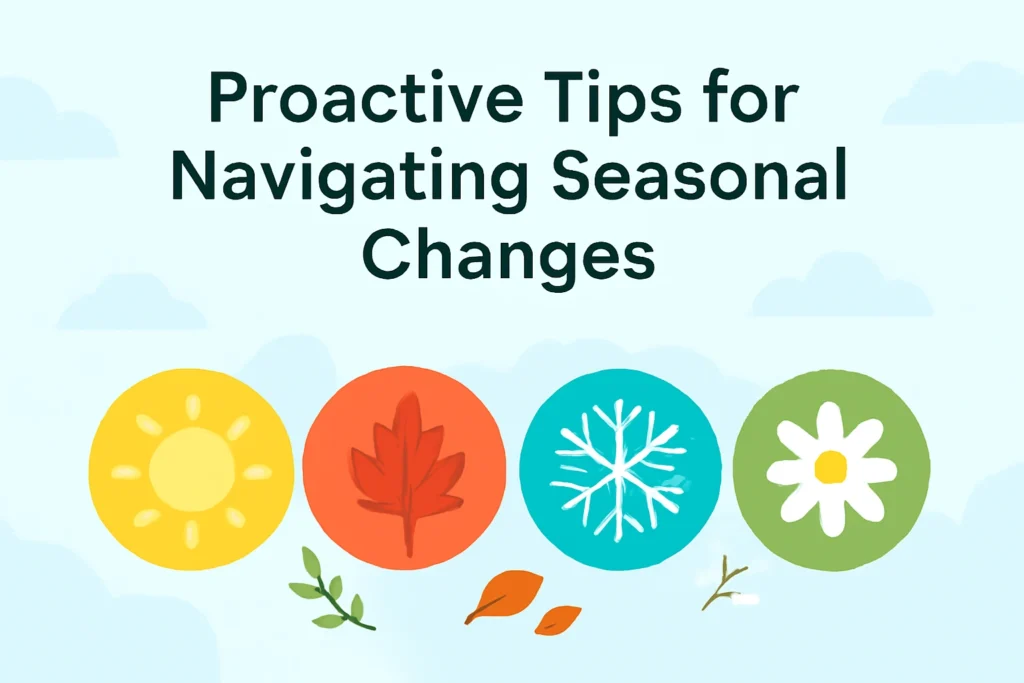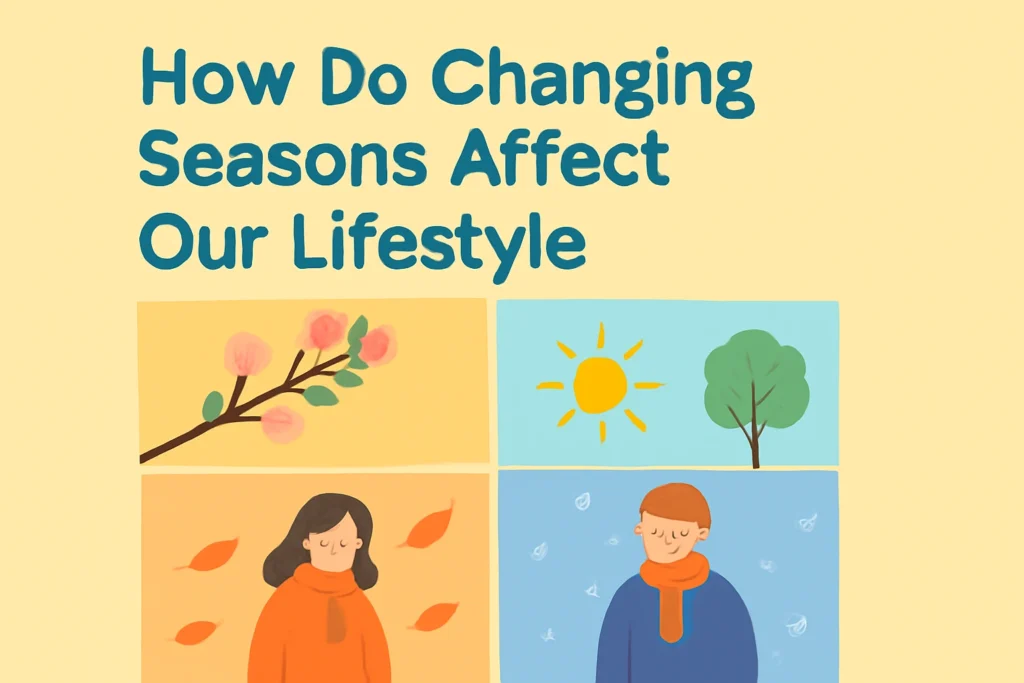Introduction to Seasonal Shifts
Seasonal change is more than just a shift in scenery; it shapes the rhythm of daily life. As temperature, daylight hours, and weather patterns fluctuate throughout the year, people experience noticeable changes in mood, energy levels, and overall well-being. Longer days in warmer months often boost outdoor activity, vitamin D production, and social engagement, while colder seasons can bring reduced sunlight, slower routines, and a higher risk of seasonal affective disorder. These natural cycles influence everything from our sleep patterns to our physical and mental health, making it important to recognize how do changing seasons affect our lifestyle and guide our choices year-round.
The Science Behind Changing Seasons
The changing of the seasons is driven by predictable seasonal cycles that influence both climate and human behavior. These shifts affect temperature, daylight hours, and humidity, all of which have a direct impact on physical and mental health, explaining how do changing seasons affect our lifestyle in different ways.
How Earth’s Tilt Creates Seasonal Changes
Seasonal change happens because Earth is tilted on its axis, altering sunlight exposure throughout the year. Longer days in summer months encourage outdoor activity and boost mood, while shorter winter days can lead to sluggish routines and reduced vitamin D production.
Weather Patterns and Environmental Impact
Changes in temperature and humidity shape seasonal patterns, influencing crop growth, allergen levels, and overall wellbeing, while also triggering behavioral changes as people respond to seasonal effects.
Mood and Emotional Well-being Through the Year
Seasonal change plays a powerful role in shaping mood and mental well-being. As seasons change, the balance of sunlight, temperature, and daily routine influences emotional stability, concentration, and overall happiness, reflecting how seasons impact our well-being.
Sunlight Exposure and Serotonin Production
Sunlight triggers serotonin production, which helps regulate mood and energy levels. During warmer months, increased daylight hours often boost positivity and motivation, while reduced sunlight in colder months can contribute to seasonal affective disorder and feelings of sluggishness.
Energy Levels and Seasonal Fluctuations
Temperature and daylight cycles directly affect our physical and mental energy, highlighting the effects of seasonal changes. Longer, brighter days promote outdoor activity and alertness, whereas colder, darker months may leave individuals feeling more tired, less focused, and susceptible to mood changes.
Seasonal Affective Disorder (SAD)
Seasonal affective disorder is a type of depression linked to seasonal change, often appearing during fall and winter months when daylight hours decrease. This condition affects both mood and energy, influencing daily routines and overall well-being.
Common Symptoms and Warning Signs
People experiencing SAD may notice persistent low mood, irritability, sluggishness, difficulty concentrating, and changes in sleep patterns. Physical effects can include reduced immunity and vitamin D deficiency caused by less sunlight exposure.
Who Is More at Risk and Why
Individuals living in regions with long, dark winters, limited sunlight, or extreme seasonal shifts are more susceptible. Biological factors, such as serotonin imbalance and disrupted circadian rhythm, also increase the risk of seasonal affective disorder.
Physical Health and Seasonal Transitions
Seasonal change influences physical health as temperature, humidity, and daylight patterns shift throughout the year. Each season brings unique health challenges that require awareness and proactive care to effectively respond to seasonal changes.
Winter Health Risks You Should Know
Colder months often mean higher flu prevalence, respiratory infections, and vitamin D deficiency due to less sunlight exposure. Reduced physical activity can also weaken immunity, especially when many people experience the effects of seasonal changes.
Summer Heat-Related Health Concerns
Hot weather and longer daylight hours increase the risk of dehydration, heat exhaustion, and heat-related illnesses, especially during warmer months with high humidity.
Spring and Autumn Allergies
Pollen, dust, and other allergens peak during seasonal transitions, triggering respiratory issues and hay fever, particularly in individuals sensitive to environmental changes.
Adapting Your Lifestyle to Seasonal Change
Seasonal change can influence daily rhythm, making it important to adjust habits for better physical and mental health. Small lifestyle shifts help maintain energy levels, mood stability, and overall well-being year-round.
Adjusting Sleep Patterns and Daily Routine
Aligning sleep schedules with daylight hours can improve concentration and reduce sluggishness, especially during winter months.
Seasonal Diet and Exercise Tips
Eating nutrient-rich foods, staying hydrated, and adapting workouts to suit the weather supports immunity and energy levels through all seasonal cycles.
| Season | Typical Weather Patterns | Physical Effects | Emotional/Mental Effects |
|---|---|---|---|
| Winter | Cold, reduced daylight | Low vitamin D, flu risk | Low mood, sluggishness, SAD |
| Spring | Mild, increased daylight | Allergies, immune system boost | Positive mood, increased energy |
| Summer | Hot, humid | Dehydration, heat exhaustion | Outdoor activity, irritability |
| Autumn/Fall | Cooler, shorter days | Respiratory issues, flu season | Reflective mood, reduced energy |
Mindfulness and Self-care Year-Round
Practicing mindfulness, stress management, and regular outdoor activity helps individuals respond to seasonal effects with resilience and balance.
Seasonal Change Effects Table
Seasonal change impacts health and mood differently throughout the year. Understanding these seasonal patterns can help you prepare for potential challenges and take advantage of each season’s positive effects.
Staying Engaged Indoors During Colder Months
Winter often encourages us to spend more time indoors, making it the perfect season to explore hobbies and activities that keep us entertained and engaged. From reading books and trying new recipes to learning creative skills like painting or music, there are endless ways to make the colder months productive and enjoyable. For gaming enthusiasts, it can also be the ideal time to upgrade your setup and respond to seasonal changes in technology. optimize your gaming PC for a smoother, more immersive experience that mitigates the negative effects of seasonal changes.
Exploring More Resources for Seasonal Living
For those who want to go beyond the basics, there’s a wealth of seasonal lifestyle resources that can help you adapt more effectively to changes throughout the year. From practical tips on adjusting your routines to tech insights that make the transition smoother, staying informed empowers you to enjoy each season to the fullest while recognizing the change in weather. You can explore more at seasonal lifestyle resources to discover tools, guides, and innovations that make living in sync with the seasons easier and more enjoyable.
Proactive Tips for Navigating Seasonal Changes
Supporting Mental Health in All Seasons
Seasonal changes can affect mood, motivation, and emotional balance. Prioritizing regular self-care activities such as mindfulness, journaling, or connecting with supportive friends can help maintain a positive mindset year-round. Recognizing early signs of seasonal depression or stress allows for timely interventions, ensuring emotional stability.

Maintaining Physical Activity
Adjusting exercise routines to match seasonal conditions helps you stay active regardless of the weather, countering the negative effects of inactivity. In colder months, opt for indoor activities like yoga, strength training, or dance workouts. During warmer seasons, outdoor walking, hiking, or cycling can boost both physical and mental health, helping you adapt seamlessly to the change of seasons.
Nutrition and Hydration Strategies
Your diet should adapt to seasonal needs to support overall well-being. Winter may call for nutrient-rich soups, vitamin D sources, and immune-boosting foods, while summer emphasizes fresh fruits, light meals, and electrolyte-rich drinks. Staying hydrated is essential in every season, as it aids in energy maintenance, focus, and body temperature regulation, particularly during the change of seasons.
Frequently Asked Questions (FAQs)
How can I maintain good mental health during winter?
Engage in regular physical activity, spend time outdoors during daylight, maintain social connections, and practice relaxation techniques like meditation or journaling. These habits help combat low mood and boost overall mental well-being, particularly for many people experiencing symptoms of sad.
What role does sunlight play in mood regulation?
Sunlight helps regulate the body’s circadian rhythm and stimulates serotonin production, which improves mood and focus, especially during the winter season. Limited sunlight in colder months can contribute to seasonal affective disorder (SAD).
Is seasonal affective disorder common in summer?
Yes, although less common, some people experience “summer SAD,” often triggered by excessive heat, longer daylight hours, or disrupted sleep patterns. Symptoms may include anxiety, restlessness, and loss of appetite.
Can seasonal changes impact productivity?
Absolutely. Seasonal shifts affect energy levels, concentration, and motivation. For example, longer daylight in spring may enhance productivity, while shorter winter days can lead to slower work performance.
Why do I feel more tired in colder months?
Cold weather, reduced daylight, and increased melatonin production can make you feel sleepy and sluggish. Staying active, eating balanced meals, and getting enough light exposure can help fight fatigue and mitigate the negative effects of the winter season.
How can diet help me adapt to seasonal changes?
Eating seasonally available foods, increasing omega-3 intake, and incorporating fruits and vegetables rich in vitamins and minerals can strengthen immunity, improve mood, and help your body adapt to seasonal shifts.
Does vitamin D deficiency affect mood?
Yes. Vitamin D plays a role in serotonin regulation, and low levels are linked to depression and fatigue, especially in winter when sunlight exposure is limited. Supplements or vitamin D-rich foods can help.
How do I stay motivated year-round?
Set small, achievable goals, keep a consistent daily routine, find enjoyable hobbies, and stay socially engaged. Tracking progress and celebrating milestones can also boost long-term motivation.
Conclusion
Seasonal changes bring shifts in weather, daylight, and temperature that can significantly influence our mood, health, and daily lifestyle. Understanding how changing seasons affect our lifestyle helps us adapt better, from the uplifting energy of spring to the slower pace of winter.
By staying proactive and mindful—adjusting routines, supporting mental and physical well-being, and making small lifestyle tweaks—we can better understand how do changing seasons affect our lifestyle. Embracing each season’s opportunities while preparing for its challenges allows us to maintain balance, resilience, and overall wellness all year round.


